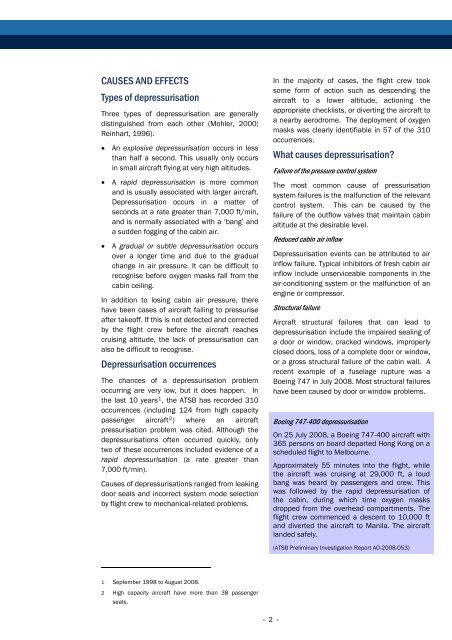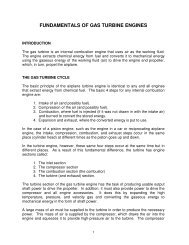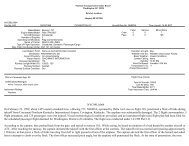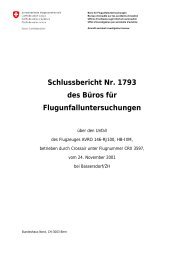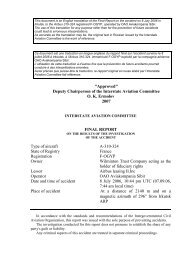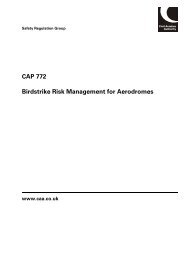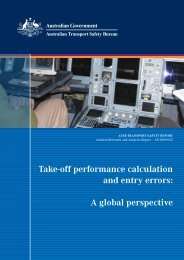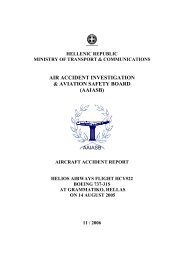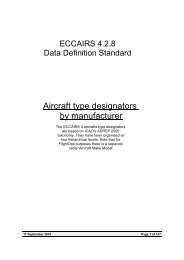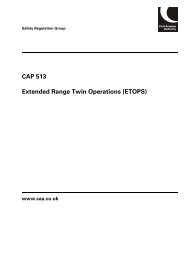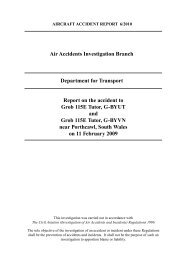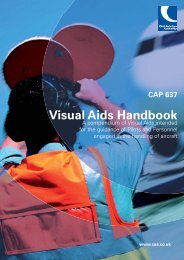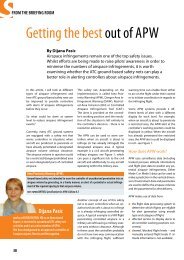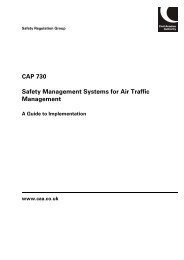Staying safe during an aircraft depressurisation - SKYbrary
Staying safe during an aircraft depressurisation - SKYbrary
Staying safe during an aircraft depressurisation - SKYbrary
You also want an ePaper? Increase the reach of your titles
YUMPU automatically turns print PDFs into web optimized ePapers that Google loves.
CAUSES AND EFFECTS<br />
Types of <strong>depressurisation</strong><br />
Three types of <strong>depressurisation</strong> are generally<br />
distinguished from each other (Mohler, 2000;<br />
Reinhart, 1996).<br />
• An explosive <strong>depressurisation</strong> occurs in less<br />
th<strong>an</strong> half a second. This usually only occurs<br />
in small <strong>aircraft</strong> flying at very high altitudes.<br />
• A rapid <strong>depressurisation</strong> is more common<br />
<strong>an</strong>d is usually associated with larger <strong>aircraft</strong>.<br />
Depressurisation occurs in a matter of<br />
seconds at a rate greater th<strong>an</strong> 7,000 ft/min,<br />
<strong>an</strong>d is normally associated with a ‘b<strong>an</strong>g’ <strong>an</strong>d<br />
a sudden fogging of the cabin air.<br />
• A gradual or subtle <strong>depressurisation</strong> occurs<br />
over a longer time <strong>an</strong>d due to the gradual<br />
ch<strong>an</strong>ge in air pressure. It c<strong>an</strong> be difficult to<br />
recognise before oxygen masks fall from the<br />
cabin ceiling.<br />
In addition to losing cabin air pressure, there<br />
have been cases of <strong>aircraft</strong> failing to pressurise<br />
after takeoff. If this is not detected <strong>an</strong>d corrected<br />
by the flight crew before the <strong>aircraft</strong> reaches<br />
cruising altitude, the lack of pressurisation c<strong>an</strong><br />
also be difficult to recognise.<br />
Depressurisation occurrences<br />
The ch<strong>an</strong>ces of a <strong>depressurisation</strong> problem<br />
occurring are very low, but it does happen. In<br />
the last 10 years 1 , the ATSB has recorded 310<br />
occurrences (including 124 from high capacity<br />
passenger <strong>aircraft</strong> 2 ) where <strong>an</strong> <strong>aircraft</strong><br />
pressurisation problem was cited. Although the<br />
<strong>depressurisation</strong>s often occurred quickly, only<br />
two of these occurrences included evidence of a<br />
rapid <strong>depressurisation</strong> (a rate greater th<strong>an</strong><br />
7,000 ft/min).<br />
Causes of <strong>depressurisation</strong>s r<strong>an</strong>ged from leaking<br />
door seals <strong>an</strong>d incorrect system mode selection<br />
by flight crew to mech<strong>an</strong>ical-related problems.<br />
1 September 1998 to August 2008.<br />
2 High capacity <strong>aircraft</strong> have more th<strong>an</strong> 38 passenger<br />
seats.<br />
In the majority of cases, the flight crew took<br />
some form of action such as descending the<br />
<strong>aircraft</strong> to a lower altitude, actioning the<br />
appropriate checklists, or diverting the <strong>aircraft</strong> to<br />
a nearby aerodrome. The deployment of oxygen<br />
masks was clearly identifiable in 57 of the 310<br />
occurrences.<br />
What causes <strong>depressurisation</strong>?<br />
Failure of the pressure control system<br />
The most common cause of pressurisation<br />
system failures is the malfunction of the relev<strong>an</strong>t<br />
control system. This c<strong>an</strong> be caused by the<br />
failure of the outflow valves that maintain cabin<br />
altitude at the desirable level.<br />
Reduced cabin air inflow<br />
Depressurisation events c<strong>an</strong> be attributed to air<br />
inflow failure. Typical inhibitors of fresh cabin air<br />
inflow include unserviceable components in the<br />
air-conditioning system or the malfunction of <strong>an</strong><br />
engine or compressor.<br />
Structural failure<br />
Aircraft structural failures that c<strong>an</strong> lead to<br />
<strong>depressurisation</strong> include the impaired sealing of<br />
a door or window, cracked windows, improperly<br />
closed doors, loss of a complete door or window,<br />
or a gross structural failure of the cabin wall. A<br />
recent example of a fuselage rupture was a<br />
Boeing 747 in July 2008. Most structural failures<br />
have been caused by door or window problems.<br />
Boeing 747-400 <strong>depressurisation</strong><br />
On 25 July 2008, a Boeing 747-400 <strong>aircraft</strong> with<br />
365 persons on board departed Hong Kong on a<br />
scheduled flight to Melbourne.<br />
Approximately 55 minutes into the flight, while<br />
the <strong>aircraft</strong> was cruising at 29,000 ft, a loud<br />
b<strong>an</strong>g was heard by passengers <strong>an</strong>d crew. This<br />
was followed by the rapid <strong>depressurisation</strong> of<br />
the cabin, <strong>during</strong> which time oxygen masks<br />
dropped from the overhead compartments. The<br />
flight crew commenced a descent to 10,000 ft<br />
<strong>an</strong>d diverted the <strong>aircraft</strong> to M<strong>an</strong>ila. The <strong>aircraft</strong><br />
l<strong>an</strong>ded <strong>safe</strong>ly.<br />
- 2 -<br />
(ATSB Preliminary Investigation Report AO-2008-053)


